Abstract
The Perinatal Multisite Databank (PMD) aims at facilitating research on perinatal mental health by collecting clinical information of patients referred for evaluations at perinatal mental health clinics across the province of Quebec, Canada with the potential to improve patient care and support evidence-based practice. This study provides a detailed description of the first 693 participants concerning psychosocial risk characteristics, the prevalence of psychiatric disorders and comorbidity during the perinatal period, the evolution of perinatal depression and anxiety symptoms over time, and the treatments received. Data were collected using clinical reports and well-validated questionnaires at multiple timepoints (from pregnancy to 6 months postpartum). Results are discussed within the context of improving patient care and disease prevention strategies in the perinatal period.
1. Introduction
The transition to motherhood can be challenging for many women; more than 20% of women in the peripartum period (i.e., during pregnancy and the first postpartum year) experience symptoms of anxiety or depression [1,2,3]. While anxiety and depression are frequent, women with bipolar disorder are also more likely to experience a relapse in the perinatal period [4,5,6,7]. In addition, other psychiatric diagnoses are also more prevalent in this period, such as obsessive–compulsive disorder [8]. Postpartum psychosis, while rare, remains a severe puerperal psychiatric disorder, potentially endangering the life of the woman and her child [9]. Importantly, suicide constitutes one of the leading causes of maternal death in high-income countries [10]. Perinatal mental health problems should be taken seriously since, in addition to affecting women’s well-being and functioning during the important transition to parenthood, they can also influence children’s emotional, cognitive, and social development at various stages of development [11,12,13].
Despite the increased prevalence of psychiatric disorders in the perinatal period and their potentially negative consequences for the whole family, there is a paucity of comprehensive clinical databanks focusing on women’s mental health in the perinatal period. Some of the reasons include challenges in recruiting and retaining pregnant participants due to time and cost constraints, as well as the burden on patients and clinicians, and the large heterogeneity in terms of treatments and treatment outcomes [14]. These difficulties leave many critical research questions unanswered despite the wealth of data collected by physicians during regular clinical appointments. Integrating data collection into clinical settings, with the help of clinicians, provides an efficient and practical solution to these challenges. Utilizing databanks for psychiatric research is relatively inexpensive and has the potential to reduce expenses while enhancing outcomes for both patients and health care providers [15,16]. Leveraging multisite clinical databanks offers significant benefits. It enables the analysis of health records on a larger scale with more diverse samples, enhancing statistical power, generalizability, and the ability to study subtype within heterogeneous diagnostic groups [17]. Furthermore, these databanks facilitate increased collaboration between research sites during longitudinal studies, leading to results that are more comparable through the use of standardized methods and reduced site-specific variations.
Thus, in 2018, the Perinatal Multisite Databank (PMD) was established in Quebec with the aim to facilitate research on perinatal mental health by collecting data on women who receive psychiatric services during the peripartum period. The purpose and development of the PMD has been previously described in detail in Kattan et al. [18]. Briefly, the PMD aims to address four main areas of unanswered research questions concerning perinatal mental health: (1) the factors that differentiate between those with perinatal distress and those with more severe perinatal psychiatric disorders, (2) the course of different perinatal mental disorders, (3) the best treatments and practices across the spectrums of clinical severity and perinatal stage (pregnancy trimesters and postpartum period) for different disorders, and (4) the effects that sociodemographic variables have on treatment adherence and effectiveness [18]. Kattan et al. [18] also presented a demographic overview of the first 225 participants. To date, the number of participants in the databank has more than tripled, totaling 693 participants, and new sites have been added. The goal of the present study is to provide a cohort update of the PMD, one of the few large-scale databanks of perinatal psychiatric patients. Here, we present a detailed description of their sociodemographic and psychosocial risk characteristics, psychiatric history, current rates of diagnoses, types of treatment, and the evolution of their anxiety and depressive symptoms over the perinatal period.
2. Materials and Methods
In 2014, a perinatal reproductive psychiatry network was established by researchers and clinicians from six hospital sites that offer perinatal psychiatric services to obstetrical patients in Montreal and Quebec City. These sites included the Jewish General Hospital, Saint-Mary’s Hospital, McGill University Health Center, Hôpital du Sacré-Coeur-de-Montréal, Centre hospitalier universitaire Sainte-Justine, and the Centre intégré universitaire de santé et de services sociaux de la Capitale-Nationale. Some of these sites are specialized in following high-risk obstetrical patients, that is, patients whose pregnancies are more at risk of developing complications. Other sites are community hospitals following patients who have a low risk of developing obstetrical-related complications. Data collection for the PMD began in 2018. In 2023 and 2024, two new sites were added: the Centre hospitalier de l’Université de Montréal and the Douglas Mental Health University Institute. The network’s overarching goal was to create a mechanism to collect standardized patient data for clinical and research purposes, such that information collected during clinical appointments could be stored in a secure databank that protects patient confidentiality. Every attempt was made to find the right balance between burden and questionnaire length for the patient and inclusion of the most relevant information. Permission and scoring manuals were requested from authors when needed, and tools not available in French were translated and back-translated, as mental health services are offered in both French and English in Quebec [18]. The secure electronic databank selected for data collection purposes (REDCap 14.6.9) can collect data offline, function across the different sites, easily export data for analysis, and is hosted by Information Management Service at the Lady Davis Institute for Medical Research affiliated with the Jewish General Hospital in Montréal, Québec, Canada.
This cohort update describes a sample of 693 women who were either pregnant or within six months postpartum at the time of their entry in the study and have met with a perinatal mental health professional at a participating site between July 2018 (the start of the study) and July 2024. A total of 1044 women were invited to participate in the study, indicating a recruitment success rate of 66%. The majority of participants were recruited from the Montreal sites (74%), while over a quarter of the participants have been recruited at our Quebec City site (26%). Inclusion criteria included being pregnant or within 6 months after giving birth to a live baby. Exclusion criteria consisted of being younger than 18 years of age and not being able to communicate in French or English.
Eligible participants were approached before their first consultation with the perinatal mental health professional. Upon their recruitment and consent into the study, participants were asked to complete a set of questionnaires via REDCap 14.6.9 before their first meeting with the perinatal mental health specialist. Questionnaires assessed detailed sociodemographic and psychosocial risk information and anxiety and depressive symptoms. Following the first appointment with the perinatal mental health specialist, the specialists completed a clinician history-taking form that included detailed information about the patient’s personal and familial psychiatric history, current diagnoses, and treatment plan.
Women who enrolled during pregnancy received a set of follow-up questionnaires at 6 weeks postpartum and at 4–6 months postpartum. Women who enrolled in the study postpartum could do so up to six months after giving birth. As such, after their intake questionnaires, they were sent only one set of follow-up questionnaires at 4–6 months postpartum. Since the women recruited postpartum all had given birth at varying times prior to recruitment (theoretically ranging from 1 day to 6 months postpartum), it was not appropriate to send them their follow-up questionnaires at a set time. The timing of follow-up questionnaires for postnatally recruited participants included some flexibility to take into account the time that had elapsed since delivery and their recruitment into the study, while also ensuring enough time between the two postnatal questionnaires (e.g., at least 1 month for those recruited later in the postnatal period).
The timeline and measures to complete by prenatally recruited participants are shown in Table 1 and for postnatally recruited participants in Table 2. Information on the reliability and validity of each measure can be found in Kattan et al. [18].

Table 1.
Timeline of protocol 1 (first seen during pregnancy).

Table 2.
Timeline of protocol 2 (first seen after delivery).
Continuous variables are described in terms of their mean (M) and standard deviation (SD). Categorical variables are described in terms of their frequencies and percentages (%).
The databank mechanism adheres to the ethical standards set forth in the 1964 Declaration of Helsinki and its subsequent amendments. It was reviewed by the Institutional Review Board of the primary investigating site using their Multicenter Mechanism (reference code: 17-115/MP-05-2018-774), which streamlines the approval process for collaborating sites. Patients provide written informed consent before their data are included in the databank. Participants are assured that the system removes all identifying information, except for email addresses, which are stored in the databank. Email addresses are heavily protected behind several layers of security provided by the software system and can be accessed only by specified members of the research team to contact participants for future phases of the study. Further details can be found in Kattan et al. [18].
3. Results
3.1. Sociodemographic Characteristics
Of the 693 participants, 522 (75.3%) were pregnant at the time of their entry into the study (Table 1). The age of the participants varied between 19 and 48 years old (M = 32.7 years, SD = 4.8 years). The majority (87.8%) of the participants were married or living with their partner. More than 2/3 of our sample was born in Canada and 1.5% were refugees. Caucasian participants comprised the majority (68.1%) of the sample. Those who identified as being Black, Middle Eastern, Asian, or Hispanic were less than 10% each. Indigenous participants comprised only 1% of the sample. Over 60% of women had a university degree, while 16.3% had a high school diploma or less. Close to half of the participants declared an annual household income of CAD 100,000 or greater. More than half of the women (56.7%) were not currently working, while the remaining 43.3% were employed and working (full- or part-time) at their entry into the study. Detailed sociodemographic characteristics of the databank are shown in Table 3.

Table 3.
Sociodemographic characteristics of the PMD to date (N = 693).
3.2. Psychiatric History and Current Psychiatric Diagnoses
3.2.1. Personal Psychiatric History
Anxiety disorder was the most common in patients’ personal psychiatric history (59.7%) closely followed by depressive disorders (50.3%). The least common psychiatric history was schizophrenia spectrum and other psychotic disorders (3.3%), while substance use disorders, bipolar and related disorders, trauma and stressor-related disorders, and eating disorders were all below 10%. Patients may have more than one psychiatric diagnosis. Detailed personal psychiatric history is shown in Figure 1.
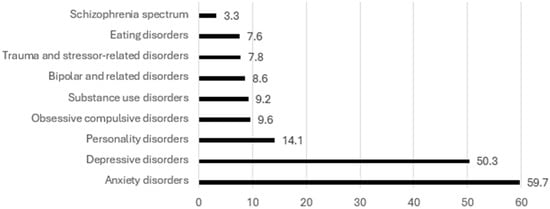
Figure 1.
Personal psychiatric history (N = 693).
3.2.2. Family History of Psychiatric Disorders
Similarly to personal psychiatric history, the two most common psychiatric diagnoses in the family history were depressive disorders (39.5%) and anxiety disorders (28.9%). Interestingly, substance use disorders were more common in patients’ family history than personal history (22.4% vs. 9.2%). Many participants also had a family history of bipolar and related disorders (16%) and schizophrenia spectrum disorders (9.2%). Obsessive–compulsive disorders, eating disorders, and trauma and stressor-related disorders were the least common in patients’ family history, all representing under 5% of the sample. Participant’s family may have more than one psychiatric diagnosis. Detailed family history of psychiatric disorder(s) of patients is shown in Figure 2.
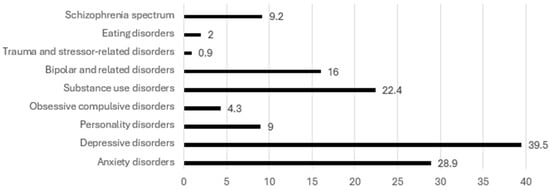
Figure 2.
Family history of psychiatric disorder(s) (N = 693).
3.2.3. Current Psychiatric Diagnoses
Most participants were diagnosed with an anxiety disorder (53.4%; Table 4). The most prevalent anxiety disorder was generalized anxiety disorder with more than a third of the sample having this diagnosis. Depressive disorders were also common (35.6%), particularly major depressive disorder (30.3%). Adjustment disorder was diagnosed in 14.0% of the sample, which is in line with the fact that the population studied is a clinical one. Trauma and stressor-related disorders were diagnosed in 12.0% of the sample. However, only a little over half of those were diagnosed with a posttraumatic stress disorder. Close to 12% of the sample was diagnosed with a personality disorder, oftentimes borderline personality disorder (7.5%) or obsessive–compulsive personality disorder (4.3%). Around 10% of the sample had a diagnosis of obsessive–compulsive and related disorder, and another 10.2% were diagnosed with an attention deficit/hyperactivity disorder. Bipolar disorders were diagnosed in 6.9% of the sample. Less prevalent diagnoses included substance use disorders (5.2%), eating disorders (3.9%), schizophrenia spectrum and other psychotic disorders (2.5%), and somatic disorders (1.2%).

Table 4.
Current psychiatric diagnoses (N = 693).
Comorbidity was common in the sample. At intake, close to half of the sample had more than one diagnosis (46.9%), and one in five participants (20.1%) had three or more diagnoses (Figure 3).
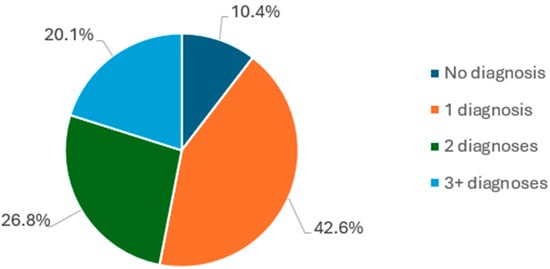
Figure 3.
Number of comorbidities.
3.3. Treatments
Both non-pharmacological and pharmacological treatments were suggested by the perinatal mental health professionals, however, non-pharmacological treatments were prioritized over pharmacological treatments, with 70.7% of the sample being recommended psychotherapy (Table 5). Moderate physical activity was recommended to 12.4% of the sample and medical leave was prescribed to 8.9%. Among the different pharmacotherapies, antidepressants were most often prescribed (38.5%). Other medications prescribed included antipsychotics (11.1%), benzodiazepines (6.1%), non-benzodiazepine hypnotics (1.0%), mood stabilizers (0.9%), and stimulants (0.6%).

Table 5.
Non-pharmacological and pharmacological treatments prescribed to PMD participants.
3.4. The Course of Perinatal Depressive and Anxiety Symptoms
3.4.1. Depressive Symptoms
At study entry, both the prenatally and postnatally enrolled participants had high levels of depressive symptoms, with a mean EPDS score above 13 in both groups, indicating a high likelihood of clinical depression (Figure 3). The prenatal group was assessed at intake (i.e., anytime during pregnancy), 6 weeks postpartum, and 4–6 months postpartum. The postnatal group was assessed at intake (i.e., 0–6 months postpartum) and at 4–6 months postpartum (where applicable). The cutoff score for clinically relevant depression varies between studies but 13 is considered a widely used threshold [19]. With time, both groups showed a decreasing trend with EPDS scores around 9 at the 4–6-month follow-up (Figure 4).
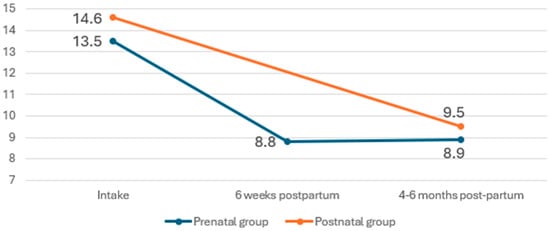
Figure 4.
Depressive symptoms (EPDS scores) at the different assessment points.
3.4.2. Anxiety Symptoms
The prenatal group was assessed at intake (i.e., anytime during pregnancy), 6 weeks postpartum, and 4–6 months postpartum. The postnatal group was assessed at intake (i.e., 0–6 months postpartum) and at 4–6 months postpartum (where applicable). Prenatally recruited participants had on average mild levels of anxiety at intake (GAD-7 M = 9.4, SD 5.4), while postnatally recruited participants had moderate levels of anxiety (M = 10.7, SD = 5.6), given the commonly used GAD-7 cutoff bands of 5–9 and 10–14 indicating mild and moderate anxiety, respectively [20] (Figure 5). Similarly to depressive symptoms, anxiety symptoms also improved during the postnatal period and remained mild in both prenatally and postnatally recruited participants (Figure 5).
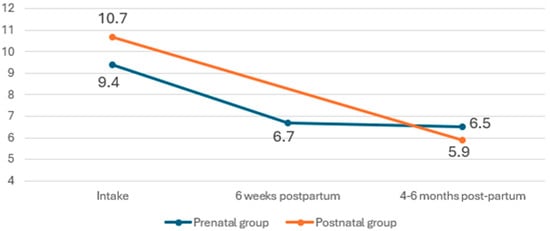
Figure 5.
Anxiety symptoms (GAD-7 scores) at the different assessment points.
4. Discussion
This cohort update provides a detailed description of the clinical, sociodemographic, and psychosocial characteristics of participants in the Perinatal Multisite Databank, a unique clinical cohort of patients who received perinatal psychiatric services in Quebec.
Most of the demographic and psychosocial characteristics are in line with those generally observed in the province of Quebec, indicating that a clinical population of women in the perinatal period may not vary significantly, at least on the studied characteristics, from the general population of women in the same age range. However, some results are noteworthy, including the proportion of women born in Canada. According to Statistics Canada, in 2021, 76% of women aged 20–49 years living in Quebec were born in Canada [21], while only 68% of our participants were Canadian born. This may suggest that our sample is somewhat more diverse than the general population in the province of Quebec. However, in the city of Montreal, which is where most of our recruitment took place (six of our seven sites), there are twice as many immigrants compared to the rest of the province [22]. In light of this, it is not surprising that immigrant women are slightly over-represented in our sample.
Another noteworthy result is the high prevalence of highly educated women in our sample, especially given that recruitment was performed in a clinical context. A lower educational level is considered a risk factor for developing perinatal mental health disorders [23,24]. Nevertheless, women living in Montreal are generally more highly educated with approximately 55.5% having a university degree in 2023 [25]. Thus, our results may be partly explained by the fact that larger proportions of Montreal residents tend to study in higher education than residents in the rest of the province of Quebec. It is likely that the educational composition of our sample will change, as more participants residing outside of Montreal will participate in the databank.
Anxiety and depressive disorders are the most prevalent diagnoses among mental health problems in the perinatal period (~20%) [7], which was also reflected in our databank. An important risk factor for perinatal depression is having a personal history of depression, potentially increasing the risk of developing postpartum depression by 20 times [26]. Moreover, a family history of psychiatric disorders and the presence of a comorbid psychiatric disorder are further important risk factors for developing an anxiety disorder in the perinatal period [23].
We observed that 46.9% of databank participants had more than one concomitant diagnosis, and, among participants who had a diagnosis (not everyone met criteria for a clinical diagnosis), more than half (52%) presented comorbidities. This overlaps with the lower end of the range that is generally reported for psychiatric comorbidities outside the perinatal period (12-month comorbidity between 50 and 70%) [27,28]. Data regarding the prevalence of psychiatric comorbidities in the perinatal period are scarce. One recent study found that 43% of their participants with a perinatal psychiatric diagnosis had more than one diagnosis [29]. This figure is lower than our findings, likely due to the authors’ methodological decision to consider only four DSM diagnoses alongside suicide risk.
As per the American Psychiatric Association guidelines, clinicians must balance the risks of an untreated major depressive disorder in pregnant women and the risks of using antidepressants [30]. Accordingly, non-pharmacological treatments (e.g., psychotherapies) should be part of the first-line treatment for mild to moderate depression during this period if patients are open to such treatment and it is accessible in terms of cost and wait times. Similarly, Canadian guidelines on the treatment of anxiety disorders advocate for the use of psychotherapy or antidepressant medication [31]. While the natural course of perinatal anxiety disorders tends to decrease in severity and prevalence over time [32], the natural course of perinatal depression tends to remain stable over time [33]. Mental health specialists involved in the PMD followed the above guidelines and our findings showed consistent improvements in both anxious and depressive symptoms of patients over the perinatal period.
Despite the important strengths of the databank, this study has limitations. While a mental health specialist interviewed the participants and provided clinical diagnoses, a large proportion of additional information was self-reported, such as psychosocial risk and anxiety and depressive symptoms. Furthermore, most of the participants to date have been recruited in Montreal, potentially biasing the results in favor of a representation of this urban population rather than the population of the entire province, limiting the generalizability of our findings. However, this limitation will be attenuated as the PMD grows and new sites will be included from other areas of the province (e.g., the Centre intégré de santé et de services sociaux des Laurentides), which will make future results more generalizable to the population of Quebec. Additionally, while the perinatal period is often considered to continue up to one year postpartum, our data collection was limited to six months postpartum due to feasibility constraints.
Avenues for future research in perinatal mental health might include considering studying the impact of social determinants of health on women’s mental health and collecting data on perinatal mental health up to one year after giving birth.
5. Conclusions
The PMD is the only databank in Quebec collecting data on mental health in a clinical sample during the perinatal period, prospectively and across multiple sites. The present study adds significant information to the current landscape of perinatal psychiatry services by presenting characteristics of a large perinatal psychiatric sample, as well as data on risk factors, prevalence of diagnoses, psychiatric history, comorbidities, treatments, and the evolution of anxious and depressive symptoms during the perinatal period. The PMD also provides rich data for research collaborations in the field of perinatal mental health.
Author Contributions
Conceptualization, R.W.-G., B.H., H.S., M.-J.P., M.S.-A., I.S. and P.Z.; methodology, M.A., P.Z., C.M.H. and E.S.; validation, C.M.H. and E.S.; formal analysis, M.A. and F.F.A.; investigation, M.A., P.Z., C.M.H. and E.S.; resources, F.F.A., R.W.-G., B.H., S.K., I.C., H.S., K.G., M.-J.P., A.W., K.T., M.S.-A., I.S., P.Z. and E.S.; data curation, K.K. and F.F.A.; writing—original draft preparation, M.A. and E.S.; writing—review and editing, F.F.A., R.W.-G., K.K., B.H., S.K., I.C., H.S., K.G., M.-J.P., A.W., K.T., M.S.-A., I.S., P.Z., C.M.H. and E.S.; visualization, M.A. and E.S.; project administration, K.K.; funding acquisition, E.S. All authors have read and agreed to the published version of the manuscript.
Funding
This research was funded by research funds from the LADY DAVIS INSTITUTE FOR MEDICAL RESEARCH, grant number 102924 to Eszter Szekely and the FONDS DE RECHERCHE DU QUÉBEC—SANTÉ, grant number FRQS CB—331904; JC—340101 to Eszter Szekely.
Institutional Review Board Statement
The study was conducted in accordance with the Declaration of Helsinki and approved by the Institutional Review Board of the primary investigating site, the Jewish General Hospital, using their Multicenter Mechanism (reference code: 17-115/MP-05-2018-774) on 16 October 2017.
Informed Consent Statement
Informed consent was obtained from all subjects involved in the study.
Data Availability Statement
The data presented in this study are available on request from the corresponding author due to ethical reasons.
Acknowledgments
We thank all research participants of the Perinatal Multisite Databank for their time and effort.
Conflicts of Interest
The authors declare no conflicts of interest. The funders had no role in the design of the study; in the collection, analyses, or interpretation of data; in the writing of the manuscript; or in the decision to publish the results.
Abbreviations
The following abbreviations are used in this manuscript:
| PMD | Perinatal Multisite Databank |
| EPDS | Edinburgh Postnatal Depression Scale |
| GAD | Generalized Anxiety Disorder |
References
- Andersson, L.; Sundström-Poromaa, I.; Wulff, M.; Aström, M.; Bixo, M. Depression and anxiety during pregnancy and six months postpartum: A follow-up study. Acta Obstet. Et Gynecol. Scand. 2006, 85, 937–944. [Google Scholar] [CrossRef]
- Maternal Mental Health in Canada, 2018/2019. Available online: https://www150.statcan.gc.ca/n1/en/daily-quotidien/190624/dq190624b-eng.pdf?st=o6Jzy_ep (accessed on 25 May 2024).
- Fawcett, E.J.; Fairbrother, N.; Cox, M.L.; White, I.R.; Fawcett, J.M. The Prevalence of Anxiety Disorders During Pregnancy and the Postpartum Period: A Multivariate Bayesian Meta-Analysis. J. Clin. Psychiatry 2019, 80, 1181. [Google Scholar] [CrossRef] [PubMed]
- Kendell, R.E.; Chalmers, J.C.; Platz, C. Epidemiology of puerperal psychoses. Br. J. Psychiatry 1987, 150, 662–673. [Google Scholar] [CrossRef] [PubMed]
- Viguera, A.C.; Whitfield, T.; Baldessarini, R.J.; Newport, D.J.; Stowe, Z.; Reminick, A.; Zurick, A.; Cohen, L.S. Risk of recurrence in women with bipolar disorder during pregnancy: Prospective study of mood stabilizer discontinuation. Am. J. Psychiatry 2007, 164, 1817–1824. [Google Scholar] [CrossRef]
- Vladimirova, R.; Stoyanova, V.; Milanova, V. Bipolar affective disorder, pregnancy and childbirth: Clinical characteristics and heredity. Biotechnol. Biotechnol. Equip. 2016, 30, 976–983. [Google Scholar] [CrossRef]
- Howard, L.M.; Khalifeh, H. Perinatal mental health: A review of progress and challenges. World Psychiatry 2020, 19, 313–327. [Google Scholar] [CrossRef] [PubMed]
- Russell, E.J.; Fawcett, J.M.; Mazmanian, D. Risk of obsessive-compulsive disorder in pregnant and postpartum women: A meta-analysis. J. Clin. Psychiatry 2013, 74, 377–385. [Google Scholar] [CrossRef]
- Friedman, S.H.; Reed, E.; Ross, N.E. Postpartum Psychosis. Curr. Psychiatry Rep. 2023, 25, 65–72. [Google Scholar] [CrossRef]
- Grigoriadis, S.; Wilton, A.S.; Kurdyak, P.A.; Rhodes, A.E.; VonderPorten, E.H.; Levitt, A.; Cheung, A.; Vigod, S.N. Perinatal suicide in Ontario, Canada: A 15-year population-based study. Can. Med. Assoc. J. 2017, 189, E1085–E1092. [Google Scholar] [CrossRef]
- Santé Mentale et Troubles Mentaux. Available online: https://www.inspq.qc.ca/sites/default/files/documents/information-perinatale/sante-mentale.pdf (accessed on 3 June 2024).
- Saharoy, R.; Potdukhe, A.; Wanjari, M.; Taksande, A.B. Postpartum Depression and Maternal Care: Exploring the Complex Effects on Mothers and Infants. Cureus 2023, 15, e41381. [Google Scholar] [CrossRef]
- Wazana, A.; Székely, E.; Oberlander, T.F. Prenatal Stress and Child Development; Springer: Cham, Switzerland, 2021. [Google Scholar]
- Weinberger, M.; Oddone, E.Z.; Henderson, W.G.; Smith, D.M.; Huey, J.; Giobbie-Hurder, A.; Feussner, J.R. Multisite Randomized Controlled Trials in Health Services Research: Scientific Challenges and Operational Issues. Med. Care 2001, 39, 627–634. [Google Scholar] [CrossRef]
- Higgins, N.; Howard, L. Database use in psychiatric research: An international review. Eur. J. Psychiatry 2005, 19, 19–30. [Google Scholar] [CrossRef]
- James, A.; Costello, M. The Benefits of Incorporating Clinical Research into Physician Practices. Available online: https://www.elligohealthresearch.com/wp-content/uploads/Elligo_PhysicianPaper_11-15-19_VF.pdf (accessed on 25 October 2024).
- Flynn, L. The Benefits and Challenges of Multisite Studies: Lessons Learned. AACN Adv. Crit. Care 2009, 20, 388–391. [Google Scholar] [CrossRef] [PubMed]
- Kattan, W.; Avigan, L.; Hayton, B.; Barkin, J.L.; St-André, M.; Nguyen, T.V.; Schwartz, H.; Poulin, M.J.; Stikarovska, I.; Wolde-Giorghis, R.; et al. Creating a Multisite Perinatal Psychiatry Databank: Purpose and Development. Int. J. Environ. Res. Public Health 2020, 17, 9352. [Google Scholar] [CrossRef] [PubMed]
- Cox, J.L.; Holden, J.M.; Sagovsky, R. Detection of postnatal depression. Development of the 10-item Edinburgh Postnatal Depression Scale. Br. J. Psychiatry 1987, 150, 782–786. [Google Scholar] [CrossRef]
- Spitzer, R.L.; Kroenke, K.; Williams, J.B.; Löwe, B. A brief measure for assessing generalized anxiety disorder: The GAD-7. Arch. Intern. Med. 2006, 166, 1092–1097. [Google Scholar] [CrossRef]
- Population Du Québec Selon L’âge Et Le Genre. Available online: https://statistique.quebec.ca/vitrine/egalite/dimensions-egalite/demographie/population-quebec-selon-age-et-sexe?onglet=groupes-population (accessed on 2 October 2024).
- Série « Perspective Géographique », Recensement De La Population De 2021. Available online: https://www12.statcan.gc.ca/census-recensement/2021/as-sa/fogs-spg/Page.cfm?lang=F&topic=9&dguid=2021A00052466023 (accessed on 2 October 2024).
- Furtado, M.; Chow, C.H.T.; Owais, S.; Frey, B.N.; Van Lieshout, R.J. Risk factors of new onset anxiety and anxiety exacerbation in the perinatal period: A systematic review and meta-analysis. J. Affect. Disord. 2018, 238, 626–635. [Google Scholar] [CrossRef]
- Yang, K.; Wu, J.; Chen, X. Risk factors of perinatal depression in women: A systematic review and meta-analysis. BMC Psychiatry 2022, 22, 63. [Google Scholar] [CrossRef]
- Répartition De La Population De 25 à 64 ans Selon le Plus Haut Niveau De Scolarité Atteint, La Région Administrative, L’âge Et Le Sexe, Québec, 1990–2023. Available online: https://statistique.quebec.ca/fr/document/repartition-de-la-population-de-25-a-64-ans-selon-le-plus-haut-niveau-de-scolarite-atteint-la-region-administrative-lage-et-le-sexe-quebec/tableau/repartition-de-la-population-de-25-a-64-ans-selon-le-plus-haut-niveau-de-scolarite-atteint-la-region-administrative-lage-et-le-sexe-quebec#tri_tertr=50040009500000000&tri_sexe=10&tri_age=365&tri_stat=8404 (accessed on 2 October 2024).
- Silverman, M.E.; Reichenberg, A.; Savitz, D.A.; Cnattingius, S.; Lichtenstein, P.; Hultman, C.M.; Larsson, H.; Sandin, S. The risk factors for postpartum depression: A population-based study. Depress. Anxiety 2017, 34, 178–187. [Google Scholar] [CrossRef]
- ter Meulen, W.G.; Draisma, S.; van Hemert, A.M.; Schoevers, R.A.; Kupka, R.W.; Beekman, A.T.F.; Penninx, B.W.J.H. Depressive and anxiety disorders in concert–A synthesis of findings on comorbidity in the NESDA study. J. Affect. Disord. 2021, 284, 85–97. [Google Scholar] [CrossRef]
- Kessler, R.C.; Berglund, P.; Demler, O.; Jin, R.; Koretz, D.; Merikangas, K.R.; Rush, A.J.; Walters, E.E.; Wang, P.S. The Epidemiology of Major Depressive Disorder Results from the National Comorbidity Survey Replication (NCS-R). JAMA 2003, 289, 3095–3105. [Google Scholar] [CrossRef] [PubMed]
- Craemer, K.A.; Garland, C.E.; Sayah, L.; Duffecy, J.; Geller, S.E.; Maki, P.M. Perinatal mental health in low-income urban and rural patients: The importance of screening for comorbidities. Gen. Hosp. Psychiatry 2023, 83, 130–139. [Google Scholar] [CrossRef] [PubMed]
- American Psychiatric Association. Practice Guideline for the Treatment of Patients with Major Depressive Disorder, 3rd ed.; American Psychiatric Association: Washington, DC, USA, 2010; pp. 69–71. [Google Scholar]
- Katzman, M.A.; Bleau, P.; Blier, P.; Chokka, P.; Kjernisted, K.; Van Ameringen, M.; the Canadian Anxiety Guidelines Initiative Group on behalf of the Anxiety Disorders Association of Canada/Association Canadienne des troubles anxieux and McGill University. Canadian clinical practice guidelines for the management of anxiety, posttraumatic stress and obsessive-compulsive disorders. BMC Psychiatry 2014, 14, S1. [Google Scholar] [CrossRef] [PubMed]
- Buist, A.; Gotman, N.; Yonkers, K.A. Generalized anxiety disorder: Course and risk factors in pregnancy. J. Affect. Disord. 2011, 131, 277–283. [Google Scholar] [CrossRef]
- Kee, M.Z.L.; Cremaschi, A.; De Iorio, M.; Chen, H.; Montreuil, T.; Nguyen, T.V.; Côté, S.M.; O’Donnell, K.J.; Giesbrecht, G.F.; Letourneau, N.; et al. Perinatal Trajectories of Maternal Depressive Symptoms in Prospective, Community-Based Cohorts Across 3 Continents. JAMA Netw. Open 2023, 6, e2339942. [Google Scholar] [CrossRef]
Disclaimer/Publisher’s Note: The statements, opinions and data contained in all publications are solely those of the individual author(s) and contributor(s) and not of MDPI and/or the editor(s). MDPI and/or the editor(s) disclaim responsibility for any injury to people or property resulting from any ideas, methods, instructions or products referred to in the content. |
© 2025 by the authors. Licensee MDPI, Basel, Switzerland. This article is an open access article distributed under the terms and conditions of the Creative Commons Attribution (CC BY) license (https://creativecommons.org/licenses/by/4.0/).